If you want to learn to play guitar, it’s important you understand the different types of guitars.
There are a lot of types of guitars and each type feels and sounds different to play. Choosing the wrong type of guitar for your style of music can make it harder to learn and won’t sound right.
In this guide, I will walk you through all types of guitars and explain which types are good for beginners, styles of music suitable for each type, and more.
Once you read this guide, check out this Guide on Guitar Sizes so you can make sure you buy the right sized guitar for you.
If you want to learn guitar, check out the 8 Step to Learn Guitar here. The guide will take you from knowing nothing about guitar to playing your first full song.
Choosing The Right Type of Guitar
The right type of guitar for you depends on what type of music you want to play, the type of sounds you want to get from your guitar, and what you like the look and feel of.
As a guitar teacher, the worst advice I regularly see on what type of guitar beginners should get is “get a nylon string acoustic because it’s easier on your fingers”.
This is the worst advice for many reasons. The biggest reason it’s the worst advice is that it doesn’t consider what type of music you want to play.
Let’s say you want to play electric guitar so you can rip up some solos and play heavy riffs with thick distortion. A classical acoustic guitar is the worst possible guitar you could buy if that’s your goal.
The right type of guitar for you is one that matches the type of music you want to play.
If you want to play heavily distorted songs, get an electric guitar. If you want to fingerpick chords to accompany your singing, get an acoustic guitar.
As you go through this guide, think about each type of guitar and whether it suits the style of music you want to play.
While some guitars may be harder to play than others, there’s nothing worse than learning on the wrong type of guitar for what you want to play.
Type of Guitar: Classical (Nylon String Acoustic)
Classical guitars are also known as nylon-string acoustic guitars due to the fact they use nylon strings.
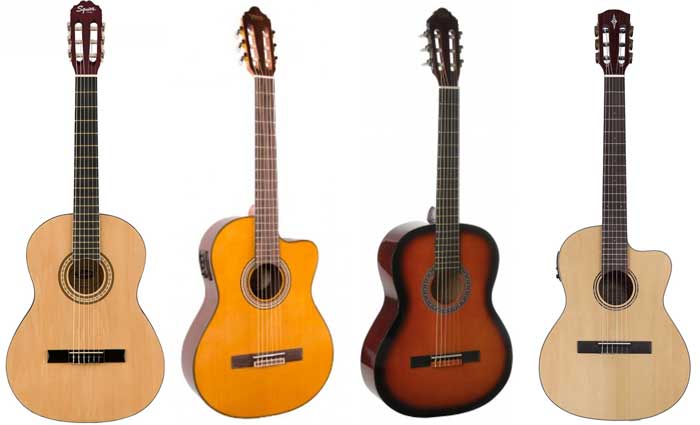
The above guitars are classical guitars. This type of guitar is acoustic, which means you don’t need to plug them in to play them.
The way to tell if a guitar is a classical guitar is to take a close look at the guitar strings:

The guitar on the right in the above photo is a ‘steel-string acoustic’. You can see that all six strings are made of metal. Four of the strings are wound in wire and the last two strings are a single wire.
The guitar on the left is a classical guitar. Three of the strings are clearly nylon, while the other three are nylon wrapped with wire. If you see a guitar with strings like this, it is probably a classical guitar.
All six strings on a classical guitar are made of nylon, but the lower three strings are wrapped in wire, so it only looks like three strings are made of nylon.
What Styles of Music Can You Play on Classical Guitars?
As you might expect, this type of guitar is the main choice with classical music. Outside of classical music, classical guitars are used in a range of styles including folk, Flamenco, pop, jazz.
Classical guitars produce a mellow tone due to the nylon strings. You can hit the strings harder to produce a harsher tone, but the overall tone is soft and mellow when compared to other types of guitars.
Can Beginners Play Classical Guitars?
As I mentioned earlier, some guitar teachers insist that beginners should always start on classical guitars.
While this is bad advice for a lot of people, classical guitars are easier to learn on than other types of guitars.
What makes classical guitars easy to play is the low string tension and wide fretboard. The low string tension simply means that you don’t need to press down hard with your fingers to play a note.
This means your fingers are less likely to hurt in the beginning when you play a classical guitar.
While everybody gets past the sore fingers stage of learning guitar, learning on a classical guitar does make the journey slightly easier.
Types of Guitar: Steel-String Acoustic
There are two types of acoustic guitars: classical and steel-string. Classical guitars use nylon strings (as explained above) and steel-string guitars are self-explanatory.
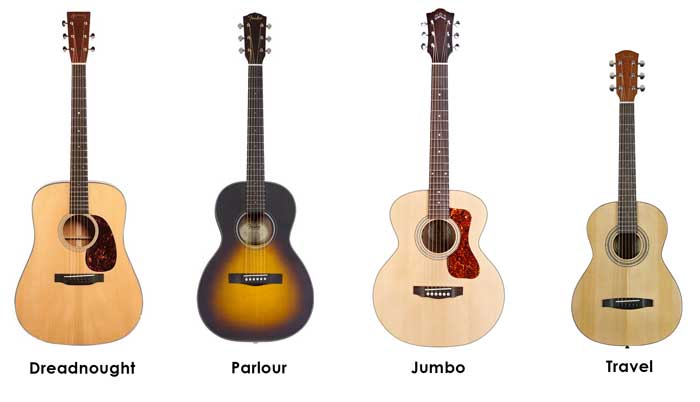
There are three main body types for steel-string acoustic guitars: dreadnought, parlour, and jumbo. There are other variations and shapes outside of these three, but they’re the most popular.
Travel guitars are also becoming popular and are great for guitarists with small hands. Find out more about travel guitars here and tips for guitarists with small hands here.
The most popular body type is a ‘Dreadnought’, but the right body type depends on what feels comfortable to you. Ed Sheeran is well known for playing reduced-size acoustic guitars (similar to the above travel guitar), so you have plenty of choice on what type you want.
What Styles of Music Can You Play on Steel-String Acoustic Guitars?
Steel-string acoustic guitars have a brighter tone when compared to classical guitars.
This brighter tone makes them the popular choice for styles of music including folk, country, blues, pop, rock, bluegrass, and others.
Can Beginners Play Steel-String Acoustic Guitars?
Beginners can successfully learn on steel-string acoustic guitars. While the steel strings do require more pressure with your fingers, a good guitar teacher will know how to properly introduce you to the guitar and build up your finger strength.
If you want to learn on a steel-string acoustic guitar and a guitar teacher tells you not to, find a different teacher.
A simple trick you can use to make a steel-string acoustic guitar feel more comfortable to play in the very beginning is to use a capo.
Place a capo on the fifth fret and suddenly you don’t need to press hard with your fingers anymore.
Then as your finger strength improves, you can move the capo down until you don’t need it anymore.
Steel-string acoustic guitars are harder to learn on when compared to classical guitars or electric guitars. But if the music you want to play is played on steel-string acoustic guitars, you won’t be happy with a classical guitar.
Types of Guitar: Electro-Acoustic
An ‘electro-acoustic’ guitar or an ‘acoustic-electric’ is simply an acoustic guitar that you can plug into an amplifier or a mixing board.
They look almost identical to a normal acoustic guitar apart from two added features:

An electro-acoustic guitar has a jack where you can plug it in, and a control panel where you can adjust the volume, EQ, insert the battery, and sometimes it includes an inbuilt tuner.
The main point to remember with electro-acoustic guitars is that that’s the only difference. You can plug them in when you want, but you can still play them as a regular unplugged acoustic.
You can buy classical guitars as electro-acoustics or steel-string guitars as electro-acoustics.
What Styles of Music Can You Play on Electro-Acoustic Guitars?
You could argue that you can play more styles of music on an electro-acoustic guitar compared to a regular acoustic guitar.
Being able to plug your acoustic guitar into an amp means you can add effects and set up different tones that are normally impossible to play with an acoustic.
In this guide, you can hear guitar effects used on acoustic guitar. The effects can enhance your tone or completely change the feel and vibe of what you are playing.
If you plan on performing live in the future, being able to plug an acoustic guitar in to an amp or pedalboard gives you great control over your tone.
Check out this guide for essential pedals for acoustic guitarists. The guide includes pedalboard examples suitable for acoustic guitarists.
[photo of acoustic guitarist plugged in]If you like the idea of playing with a looper pedal or performing live, I highly recommend getting an electro-acoustic guitar instead of a normal acoustic guitar.
Can Beginners Play Electro-Acoustic Guitars?
Electro-acoustic guitars feel exactly the same to play as normal acoustic guitars.
This means you can choose either a classical guitar or a steel-string guitar to buy as an electro-acoustic guitar.
Types of Guitar: Hollowbody & Semi-Hollow
Hollowbody and semi-hollow guitars (also known as semi-acoustic) are electric guitars with a hollowed-out body.
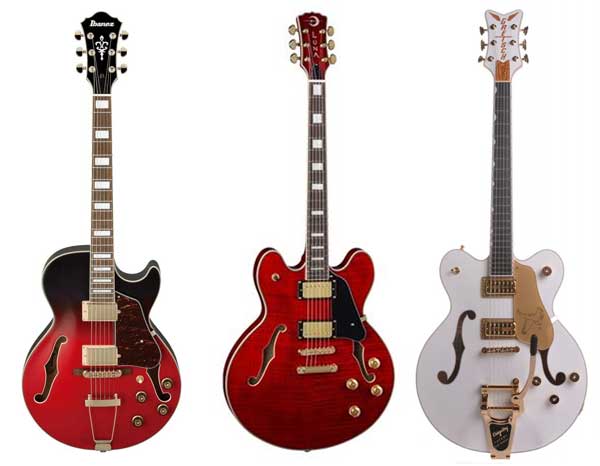
The difference between a hollowbody and a semi-hollow guitar can be seen in the internal cavity of the guitar’s body.
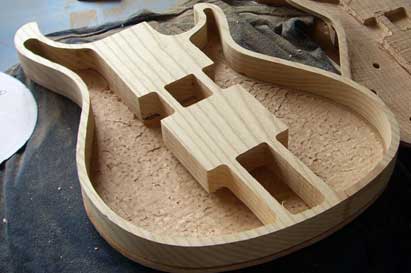
A semi-hollow guitar usually has a block of wood running through the body under the pickups and bridge as shown above. A hollowbody guitar doesn’t have this block.
Hollowbody guitars are very susceptible to feedback and don’t work very well with high output pickups and amplifiers. Semi-hollow guitars greatly reduce feedback issues while keeping the unique tone of a hollowbody.
When you play one of these guitars unplugged, it produces an acoustic-like tone. Nowhere as loud or as clear as an actual acoustic, but it is noticeably louder than a solid-body electric guitar.
When a semi-hollow guitar is plugged in, you get a tone that sounds somewhere between a regular electric guitar and an acoustic guitar. The tone is closer to electric than acoustic, but you can hear it has an acoustic quality to it.
The tone is mellow and has a unique resonance that you don’t hear in solid-body electric guitars.
What Styles of Music Can You Play on Hollowbody or Semi-Hollow Guitars?
You can probably guess what styles of music are popular on these type of guitars from the vintage look.
Hollowbody guitars were the rage in the 30s-50s and semi-hollow guitars were popular right after that as amplifiers became available to guitarists.
Old blues, jazz, early rock-n-roll, rockabilly, and similar styles all commonly use semi-hollow guitars.
Can Beginners Play Hollowbody or Semi-Hollow Guitars?
A hollowbody or a semi-hollow guitar feels very similar to a regular electric guitar.
Some beginners will find these types of guitars easy to play on, while others may have trouble with the large body.
Types of Guitar: Electric
Electric guitars are a versatile type of guitar that comes in many different shapes and sizes.
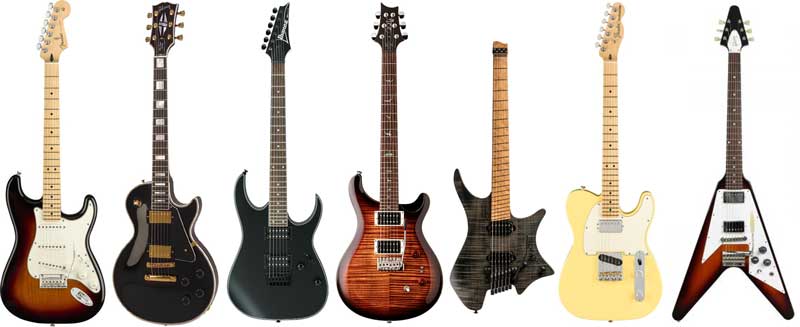
The above guitars only scratch the surface on what is possible with electric guitars.
The type of hardware used on electric guitars can be significantly different from one guitar to the next. This means every electric guitar feels different to play and can do different things.
To get an idea of the type of hardware used on different guitars, check out this Guide to Parts of the Guitar. It will teach you everything you need to know about the different parts of acoustic as well as electric guitars.
Not only can you have significantly different shapes and designs on electric guitars, but the tones produced by different electric guitars can be worlds apart.
While acoustic guitars are all similar in tone, electric guitars offer a wide range of tonal options. You can even get electric guitars with piezo pickups that make your guitar sound like an acoustic.
What Styles of Music Can You Play on Electric Guitars?
Electric guitars have been used in pretty much all styles of music at some point. They’re the go-to option in countless styles of music such as rock, metal, blues, punk, and more. It’s hard to imagine a heavy metal or rock band not using electric guitars.
There are two reasons why electric guitars can be used in almost any music style.
The first is the different tonal options in the guitars. The type of guitar and the pickups in the guitar all change the tone you hear. You can even install different pickups to access different tones.
The second is the gear you can plug an electric guitar into. There are many types of amps that all shape your guitar tone in different ways. You can go from a vintage blues tone to a modern metal tone by flicking a switch on an amp.
You can also use pedals to shape your tone in different ways. My Guitar Effects Course spends the entire first part showing you how to use a wide range of different effects, then the second part looking at how to create different tones using pedals and amps. That’s how versatile electric guitars can be.
Can Beginners Play Electric Guitars?
Beginners tend to find it easy to start learning on an electric guitar. While some electric guitars are harder to play than others, the string tension is generally lower than what it is on a steel-string acoustic guitar.
If you like the sounds an electric guitar can produce and you want to play music that is usually played on an electric guitar, it is highly recommended you start learning on an electric guitar.
If you want to play music that is usually played on an acoustic guitar, don’t start off on an electric guitar just because it might be easier to start on. Pick the type of guitar that suits the style of music you want to play.
Types of Guitar: Resonator
Resonators are a strange type of guitar that you may not see very often (depending on the style of music you listen to).
They’re basically acoustic guitars with a metal cone in place of where the soundhole normally sits.

As you might expect, this metal cone helps the guitar resonate and project any note you play. The result is a very loud and clear tone that can be surprising if you’ve never played one before.
You may have heard of a Dobro, which is a type of resonator.
What Styles of Music Can You Play on Resonator Guitars?
Resonators are typically used in bluegrass, country, Hawaiian, blues, and jazz music.
There are different models with different types of cones that are better suited to different styles of music.
A lot of resonator guitarists use a slide, but you can play a resonator as you would play a normal guitar.
Can Beginners Play Resonator Guitars?
Resonators can be harder to learn at first, but it depends on what style of music you want to play.
The high action height (find out what action height is here and why it’s important) and string tension can be an issue for some beginners.
Types of Guitar: 12-String Guitars
12-sting guitars can come in acoustic or electric types and are very similar to play as a regular 6-string guitar.
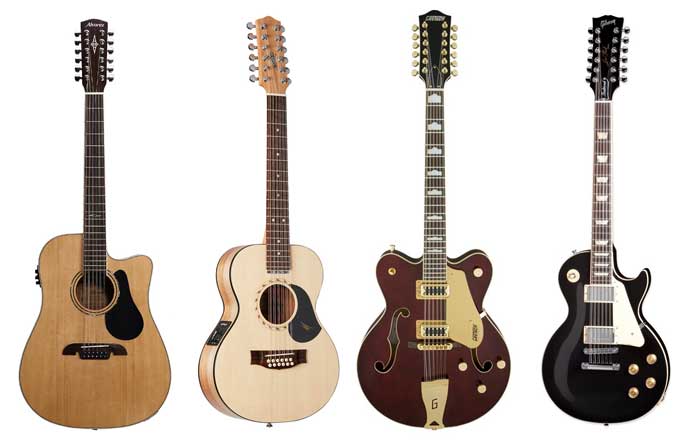
The idea behind 12-string guitars is that instead of having six strings, you double up each string. So you end up with six pairs of strings as shown below:
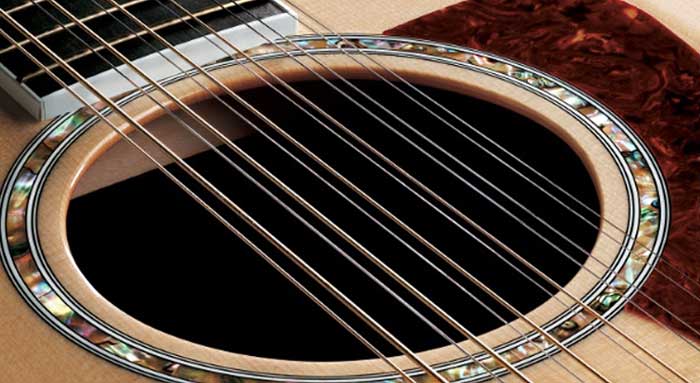
If you’re interested in how 12-string guitars are tuned, read this guide. If you already know how to play guitar, a quick read of that guide will explain how you can play a 12-string guitar.
What Styles of Music Can You Play on a 12-String Guitars?
12-string guitars were extremely popular in the 60s and 70s, but they’re still used today.
Check out this list of Songs to Learn on a 12-string Guitar for some songs with Guitar TAB to try out.
A 12-string guitar has a very distinctive sound. Once you learn to recognize it, it will stand out in any song that uses one.
Can Beginners Play 12-String Guitars?
12-string guitars require a lot of finger pressure to properly fret the notes. You need to press down hard enough for two strings to make contact with the fret under each finger, so it is harder to play than a regular 6-string guitar.
If you’re interested in learning how to play a 12-string guitar, start with a regular 6-string guitar (acoustic or electric). Once you build up your finger strength, you can work your way to playing a 12-string guitar.
Types of Guitar: Extended-Range Electric
7-string guitars have existed for a long time, but started to become popular in the 90s.
Today, you can find a wide range of 7, 8 and 9 string guitars (mostly electric) from many brands.

These extended-range guitars provide guitarists with the freedom to play anything you can play on a normal six-string guitar as well as lower notes that can reach as low as bass guitar notes.
Note: you may notice that a lot of extended range guitars have slanted frets. These are called ‘fanned’ frets or multi-scale guitars. Fanned frets are also available on 6-string guitars, but very common on extended range guitars.
Find out about fanned frets in this guide.
Find out about 7-string guitars here including different options to buy in my Ultimate Guide to Seven String Guitars.
What Styles of Music Can You Play on Extended-Range Guitars?
You can technically play any style of music on an extended range guitar. An extended range guitar simply adds additional strings, so you can play anything on it that you would normally play on a six-string guitar.
But extended range guitars tend to be used by guitarists who play heavy styles of music, as well as technical styles such as progressive metal.
Many styles of music don’t really benefit from the lower range possible on an 8 or 9 string guitar, but there are plenty of guitarists using them in styles of music you wouldn’t expect.
To hear examples of seven-string guitars in action, check out this Guide on Seven String Songs to Learn.
Can Beginners Play Extended-Range Guitars?
Many beginners will struggle at first with playing an extended-range guitar. The extra strings require a wider fretboard, which can be awkward for a beginner to reach around.
If you are interested in playing music on an extended-range guitar, try a 7-string first. If you can comfortably learn to play on a 7-string, you’ll find 6-string guitars easier to play.
8 and 9 string guitars feel like completely different instruments and almost require a completely different approach.
Types of Guitar: Bass
I’ve included bass in this guide because while it is a different instrument, many guitarists enjoy playing bass as well as guitar.
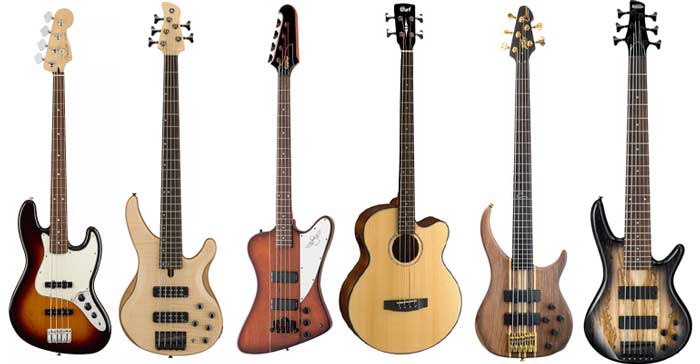
In the above photos, you can see that there is a wide range of basses available today.
Just like guitar, you can buy many different types of basses from acoustic, electro-acoustic, solid body, semi-solid, headless, 4-string, 5-string, 6-string, 8-string, and more.
If you already know how to play guitar, read this guide for step-by-step instructions on how to learn bass as a guitarist.
What Styles of Music Can You Play on Bass?
Bass can be used in any music style. If you hear a guitar in a song, then chances are you’ll hear a bass too.
Learning guitar also teaches you some skills and concepts that apply to bass, so a guitarist can pick up a bass and immediately start playing riffs and basic bass lines.
Can Beginners Play Bass?
Absolutely. Just keep in mind that bass and guitar are separate instruments. While a lot of the techniques and fretboard knowledge can be shared across the instruments, bass and guitar require very different approaches and mindsets.
If you want to learn guitar, start on a guitar and learn bass separately. If you want to learn bass, start on bass and you can consider learning guitar later on.
If you want to learn how to play bass, a good starting point is to work on these Bass Guitar Exercises. Practice these exercises daily and you’ll be surprised by how quickly you can learn to play some easy songs on bass.
Types of Guitar: Lap Steel
Lap steel, pedal steel, and Hawaiian steel guitars are interesting instruments that look similar to a regular guitar but play very differently.

These guitars are played with the body flat on your lap (or a stand) with a sound bar or slide.
What Styles of Music Can You Play on a Lap Steel?
A guitarist can take their knowledge of the fretboard and learn to play a lap steel guitar, but you do need to learn new skills and a new approach to playing music.
The name ‘Hawaiian steel guitar’ should give you a good idea of the typical type of music played on these instruments.

In addition to Hawaiian music, you can hear lap steel and pedal steel guitars used in country music and bluegrass, as well as rock, jazz, blues, and other styles.
The silky-smooth sliding between notes makes this an incredibly unique sounding instrument. You can achieve something similar with a regular guitar and a guitar slide, but it’s not quite the same.
Can Beginners Play a Lap Steel?
A lap steel guitar and a regular guitar are two different instruments. While an electric guitarist can pick up an acoustic guitar and instantly it (and vice versa), the same isn’t true with a lap steel.
Beginners can definitely learn to play a lap steel guitar, but keep in mind you’ll be learning a completely different instrument.
You won’t be able to learn to play lap steel then immediately pick up a regular guitar and play chords and riffs.
Types of Guitars FAQ
Here are some common questions beginners often have about the different types of guitars available.
How many types of guitars are there?
There are two main types of guitars: acoustic and electric. When you look at each of these types of guitars, they can be split into many different sub-types based on body shapes, hardware features, and the number of strings.
Acoustic guitars are split into two main types: steel string and nylon string (classical). Steel-string acoustic guitars are available in many different forms, while nylon string acoustics tend to stick closely to the traditional classical style.
Electric guitars can also be split into many different groups. People are still coming up with new types of electric guitars based on different styles and features.
Which type of guitar is best for beginners?
The best type of guitar for beginners is the one that you enjoy playing. If you want to play music that sounds good on an acoustic guitar, get an acoustic guitar. If you want to play music that sounds best on an electric guitar, get an electric guitar.
As explained at the top of this guide, there is a lot of bad advice on what type of guitars beginners should get. Read the start of this guide to learn more about what type of guitar you should start learning on.
What is a normal guitar called?
To a classical guitarist, they would call a normal guitar a classical guitar or nylon string guitar. To a folk or country guitarist, they would call a normal guitar a steel-string acoustic. To a rock or metal guitarist, they would call a normal guitar an electric guitar.
There are many different types of guitars as explained in this article and all of them are ‘normal’ to some guitarists. It really depends on what sounds you want to produce and what type of music you want to play.
Which type of guitar is easiest to learn?
Nylon string guitars are generally seen as the easiest type of guitar to learn to play on. The nylon strings and low string tension make it easier on your fingers. Electric guitars can also be very easy to learn on for similar reasons.
But asking which type of guitar is the easiest to learn on is the wrong question to ask. The real question you should be asking is “what type of music do I want to play?” Find the type of guitar that suits what you want to play.
What is a four-string guitar called?
If you see what looks like a guitar with four thick strings, it is probably a bass. Basses tend to use four strings, where guitars usually have six strings.
While four-string guitars do exist (they’re called tenor guitars), they are not common.
If you want to learn more about types of guitars, check out my Ultimate Guide to Guitar Parts. The guide explains all the different parts used on guitars you need to know about when learning guitar.
If you want to learn guitar, check out the 8 Step to Learn Guitar here. The guide will take you from knowing nothing about guitar to playing your first full song.
If you found this guide useful, please subscribe here for email updates and lessons.
